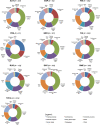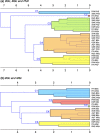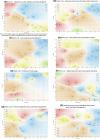Bioeconomy perception by future stakeholders: Hearing from European forestry students
- PMID: 33048322
- PMCID: PMC7568748
- DOI: 10.1007/s13280-020-01376-y
Bioeconomy perception by future stakeholders: Hearing from European forestry students
Abstract
This article provides useful information for universities offering forestry programs and facing the growing demand for bioeconomy education. An explorative survey on bioeconomy perception among 1400 students enrolled in 29 universities across nine European countries offering forestry programs was performed. The data have been elaborated via descriptive statistics and cluster analysis. Around 70% of respondents have heard about the bioeconomy, mainly through university courses. Students perceive forestry as the most important sector for bioeconomy; however, the extent of perceived importance of forestry varies between countries, most significantly across groups of countries along a North-South European axis. Although differences across bachelor and master programs are less pronounced, they shed light on how bioeconomy is addressed by university programs and the level of student satisfaction with this. These differences and particularities are relevant for potential development routes towards comprehensive bioeconomy curricula at European forestry universities with a forestry focus.
Keywords: Bioeconomy; Education; Forest-based bioeconomy; Forestry students; Future stakeholders; Perception.
Figures






References
-
- Bauer F. Narratives of biorefinery innovation for the bioeconomy-conflict, consensus or confusion? Environmental Innovation and Societal Transitions. 2018;28:96–107. doi: 10.1016/j.eist.2018.01.005. - DOI
-
- Birch K, Levidow L, Papaioannou T. Sustainable capital? The neoliberalization of nature and knowledge in the European “knowledge-based bio-economy”. Sustainability. 2010;2:2898–2918. doi: 10.3390/su2092898. - DOI
-
- Bugge MM, Hansen T, Klitkou A. What is the bioeconomy? A review of the literature. Sustainability. 2016 doi: 10.3390/su8070691. - DOI
-
- D’Amato D, Droste N, Allen M, Kettunen K, Lähtinen J, Korhonen P, Leskinen BD, Matthies, Toppinen A. Green, circular, bio economy: A comparative analysis of sustainability avenues. Journal of Cleaner Production. 2017;168:716–734. doi: 10.1016/j.jclepro.2017.09.053. - DOI
-
- Drejerska, N. 2017. Employment in vs. education for the bioeconomy. In: Proceedings of the 8th International Scientific Conference Rural Development 2017, ed. A., Raupelienė. 10.15544/RD.2017.245.
MeSH terms
LinkOut - more resources
Full Text Sources

